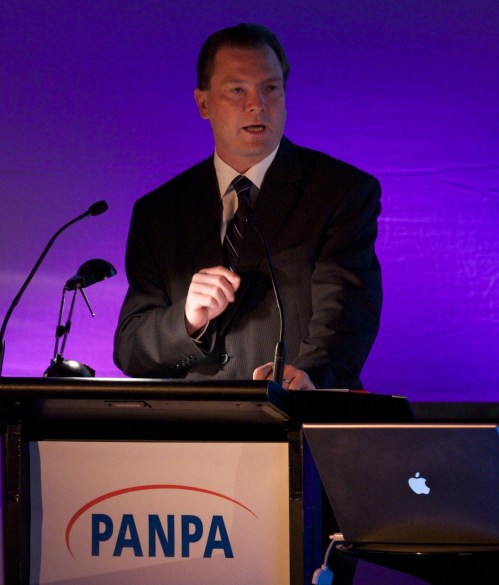
The state leader’s declaration was backed up by new research unveiled by Newspaper Works chief executive Tony Hale, who gave attendees a sneak preview of the association’s second Newspapers Today report, which will be published in full next month.
The report found that consumer perceptions about newspapers had improved markedly over the last 18 months, and largely at the expense of internet media, with Hale declaring that “perhaps the gloss is coming off of the internet”.
The report found that 50 per cent of respondents said they felt “mentally engaged” with a newspaper, as opposed to 38 per cent with the internet. Likewise, 57 per cent of those surveyed said they felt newspapers “shaped the important issues of the day”, compared with 21 per cent who said this of the internet.
In a surprise result for those who tout the immediacy of web content, 56 per cent of respondents said they “feel up to date” when they use newspapers, with only 21 per cent saying this about the internet.
In one of the biggest discrepancies between the two media, 51 per cent of respondents said that newspapers were “better respected” as a media source, compared with 13 per cent who voted for the internet.
Crucially, 44 per cent also said they regarded consuming newspapers as a “more enriching experience”, compared with 31 per cent who said this about the internet.
Indeed, newspaper perceptions improved across the board since the first Newspaper Today report in 2007. Whilst Hale could not provide any empirical data explaining the upward trend, he cited the global economic crisis as a possible factor, with the first survey taking place in June 2007, whilst this latest edition conducted its research in February of this year.
“When times are tough, people revert to what they trust,” he said.
Overall, the report backed up Hale’s assertion that “newspapers are more absorbing than YouTube, more dynamic than Apple, and more reputable than Google”.
The industry body wants to combat the belief that the newspaper industry is in its death throes as digital media takes the ascendancy.
“Let’s get something straight: newspapers in Australia are in pretty good shape,” Hale said. “Our industry is the envy of the rest of the world.”
Representing the printing industry somewhat, Océ’s European business development director Robert Koeckeis discussed the advantages of using digital print technology in newspaper production, citing the example of Spanish printer Imcodávila, which was the first newspaper printer to make use of an Océ JetStream 2200.
Imcodávila is currently producing 5000 digital newspapers a day on the press, and will take delivery of a second 2200 press as it moves to an expanded site in Madrid.
Koeckeis also pointed to UK printer Stroma’s use of digital technology to print Australian newspapers such as the Sydney Morning Herald and The Australian, which are then given to Qantas passengers on flights headed to Australia.
According to Koeckeis, Océ will also be expanding its digital newspaper network this year, opening sites in Berlin and Madrid to add to its existing bases in Los Angeles, Zurich, New York, Singapore, London and Sydney.
Meanwhile, Timothy Balding, joint chief executive of the World Association of Newspapers and News Publishers (WAN-IFRA) discussed the medium’s still market-leading position amidst all the hype about online media.
Balding claimed that newspapers still deliver 34 per cent global market reach compared with the internet’s 24 per cent reach. He also pointed out that the overwhelming majority of internet media revenues were accounted for by a single company – Google, with 65 per cent.
Whilst he acknowledged that most of the growth of newspapers was taking place in the developed world, as opposed to online media which is experiencing universal growth, Balding is adamant that the march towards the internet isn’t inevitable.
He pointed to the example of the US newspaper Newport Daily News, owned by publisher Edward A. Sherman, which has come to regard the web as something of a distraction from its core product offering. The newspaper has adopted a model which sees it only allow online access to its articles to paid subscribers of its newspaper.
In one of the day’s more entertaining speeches, London Evening Standard managing editor Doug Wills discussed the publication’s revamp following a takeover from Russian businessman and former KGB agent Alexander Lebedev.
Following Lebedev’s “out of the blue, or rather out of the ‘red'” takeover, as Wills put it, the masthead underwent a series of changes to try to combat some of the negative perceptions of the newspaper, particularly that its editorial attitude was ‘anti-London’. One of these changes was revising the name from the Evening Standard to its current London Evening Standard.
The publisher also mounted an outdoor advertising campaign which involved a series of ‘apologies’ being posted around London, such as ‘Sorry for losing touch’.
Comment below to have your say on this story.
If you have a news story or tip-off, get in touch at editorial@sprinter.com.au.
Sign up to the Sprinter newsletter


